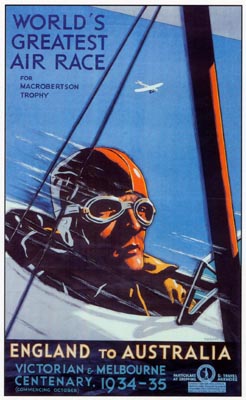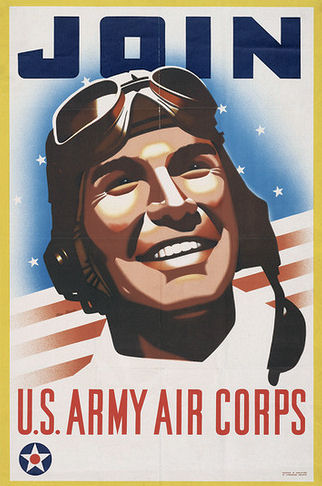|
Douglas DC-2
The Douglas DC-2 is a retired 14-passenger, twin-engined airliner that was produced by the American company Douglas Aircraft Company starting in 1934. It competed with the Boeing 247. In 1935, Douglas produced a larger version called the DC-3, which became one of the most successful aircraft in history. Design and development In the early 1930s, fears about the safety of wooden aircraft structures drove the US aviation industry to develop all-metal airliners. United Airlines had exclusive right to the all metal twin-engine Boeing 247; rival TWA issued a specification for an all-metal trimotor. The Douglas response was more radical. When it flew on July 1, 1933, the prototype DC-1 had a robust tapered wing, retractable landing gear, and two 690 hp (515 kW) Wright radial engines driving variable-pitch propellers. It seated 12 passengers. The DC-2 was longer than the DC-1, had more powerful engines, and carried 14 passengers in a 66-inch-wide cabin. Douglas test ... [...More Info...] [...Related Items...] OR: [Wikipedia] [Google] [Baidu] |
MacRobertson Air Race
The MacRobertson Trophy Air Race (also known as the London to Melbourne Air Race) took place in October 1934 in aviation, 1934 as part of the 1934 Centenary of Melbourne, Melbourne Centenary celebrations. The race was devised by the Lord Mayor of Melbourne, Sir Harold Gengoult Smith, and the prize money of £15,000 was provided by Sir Macpherson Robertson, a wealthy Australian confectionery manufacturer, on the conditions that the race be named after his MacRobertson's, MacRobertson confectionery company, and that it was organised to be as safe as possible. A further condition was that a gold medal be awarded to each pilot who completed the course within 16 days. Organisation and rules The race was organised by an Air Race Committee, with representatives from the Australian government, aviation, and Melbourne Centenary authorities. The Royal Aero Club oversaw the event. The race ran from RAF Mildenhall in East Anglia to Flemington Racecourse, Melbourne, approximately . There we ... [...More Info...] [...Related Items...] OR: [Wikipedia] [Google] [Baidu] |
Fokker
Fokker (; ) was a Dutch aircraft manufacturer that operated from 1912 to 1996. The company was founded by the Dutch aviator Anthony Fokker and became famous during World War I for its fighter aircraft. During its most successful period in the 1920s and 1930s, Fokker dominated the civil aviation market. The company's fortunes declined over the course of the late 20th century; it declared bankruptcy in 1996, and its operations were sold to competitors. History Fokker in Germany At age 20, while studying in Germany, Anthony Fokker built his initial aircraft, the Fokker Spin, ''Spin'' (Spider)—the first Dutch-built plane to fly in his home country. Taking advantage of better opportunities in Germany, he moved to Berlin, where in 1912, he founded his first company, Fokker Aeroplanbau, later moving to the Görries suburb just southwest of Schwerin (at ), where the current company was founded, as Fokker Aviatik GmbH, on 12 February 1912. World War I Fokker capitalized on having sol ... [...More Info...] [...Related Items...] OR: [Wikipedia] [Google] [Baidu] |
Douglas C-32 At Langley Field Near Base Operations
Douglas may refer to: People * Douglas (given name) * Douglas (surname) Animals * Douglas (parrot), macaw that starred as the parrot ''Rosalinda'' in Pippi Longstocking * Douglas the camel, a camel in the Confederate Army in the American Civil War Businesses * Douglas Aircraft Company * Douglas (cosmetics), German cosmetics retail chain in Europe * Douglas Holding, former German company * Douglas (motorcycles), British motorcycle manufacturer Peerage and Baronetage * Duke of Douglas * Earl of Douglas, or any holder of the title * Marquess of Douglas, or any holder of the title * Douglas baronets Peoples * Clan Douglas, a Scottish kindred * Dougla people, West Indians of both African and East Indian heritage Places Australia * Douglas, Queensland, a suburb of Townsville * Douglas, Queensland (Toowoomba Region), a locality * Port Douglas, North Queensland, Australia * Shire of Douglas, in northern Queensland Canada * Douglas, New Brunswick * Douglas Parish, New Brunswick * ... [...More Info...] [...Related Items...] OR: [Wikipedia] [Google] [Baidu] |
United States Army Air Corps
The United States Army Air Corps (USAAC) was the aerial warfare service component of the United States Army between 1926 and 1941. After World War I, as early aviation became an increasingly important part of modern warfare, a philosophical rift developed between more traditional ground-based army personnel and those who felt that aircraft were being underutilized and that air operations were being stifled for political reasons unrelated to their effectiveness. The USAAC was renamed from the earlier United States Army Air Service on 2 July 1926, and was part of the larger United States Army. The Air Corps became the United States Army Air Forces (USAAF) on 20 June 1941, giving it greater autonomy from the Army's middle-level command structure. During World War II, although not an administrative echelon, the Air Corps (AC) remained as one of the combat arms of the Army until 1947, when it was legally abolished by legislation establishing the United States Department of the Air Fo ... [...More Info...] [...Related Items...] OR: [Wikipedia] [Google] [Baidu] |
Bristol Pegasus VI
The Bristol Pegasus is a British nine-cylinder, single-row, air-cooled radial aero engine. Designed by Roy Fedden of the Bristol Aeroplane Company, it was used to power both civil and military aircraft of the 1930s and 1940s. Developed from the earlier Mercury and Jupiter engines, later variants could produce from its capacity of 1,750 cubic inches (28 L) by use of a geared supercharger. Further developments of the Pegasus created the fuel-injected Bristol Draco and the diesel Bristol Phoenix, both types being produced in limited numbers. In contrast, by the end of production over 30,000 Pegasus engines had been built. Aircraft applications ranged from single-engine biplanes to the four-engined Short Sandringham and Sunderland flying boats. Several altitude and distance records were set by aircraft using the Pegasus. The Bristol Siddeley company reused the name many years later for the turbofan engine used in the Hawker Siddeley Harrier and which became known as the Roll ... [...More Info...] [...Related Items...] OR: [Wikipedia] [Google] [Baidu] |
Pratt & Whitney R-1690
The Pratt & Whitney R-1690 Hornet was a widely used American aircraft engine. Developed by Pratt & Whitney, 2,944 were produced from 1926 through 1942. It first flew in 1927. It was a single-row, 9-cylinder air-cooled radial design. Displacement was 1,690 cubic inches (27.7 L). It was built under license in Italy as the Fiat A.59. In Germany, the BMW 132 was a developed version of this engine. The Pratt & Whitney R-1860, R-1860 Hornet B was an enlarged version produced from 1929. Variants ;R-1690-3: ;R-1690-5: ;R-1690-11: ;R-1690-13: ;R-1690-S5D1G: ;R-1690-52: ;R-1690-SDG: ;R-1690-S1EG: ;R-1690-S2EG: ;R-1690-25: ;R-1690-S1C3G: ;Fiat A.59 R.: License built in Italy with reduction gearing. ;Fiat A.59 R.C.: License built in Italy with reduction gearing and supercharger. ;BMW Hornet:License production of the Hornet in Germany, independently developed as the BMW 132. Applications Engines on display * There is a R-1690 on display at the New England Air Museum, Bradley In ... [...More Info...] [...Related Items...] OR: [Wikipedia] [Google] [Baidu] |
Wright R-1820
The Wright R-1820 Cyclone 9 is an American radial engine developed by Curtiss-Wright, widely used on aircraft in the 1930s through 1950s. It was produced under license in France as the Hispano-Suiza 9V or Hispano-Wright 9V, and in the Soviet Union as the Shvetsov M-25. Design and development The R-1820 Cyclone 9 represented a further development of the Wright P-2 engine dating back to 1925. Featuring a greater displacement and a host of improvements, the R-1820 entered production in 1931. The engine remained in production well into the 1950s. The R-1820 was built under license by Lycoming, Pratt & Whitney Canada, and also, during World War II, by the Studebaker Corporation. The Soviet Union had purchased a license for the design, and the Shvetsov '' OKB'' was formed to metricate the American specification powerplant for Soviet government-factory production as the '' M-25'', with the R-1820's general design features used by the Shvetsov design bureau for many of their futu ... [...More Info...] [...Related Items...] OR: [Wikipedia] [Google] [Baidu] |
LOT DC-2 LOC Matpc 22394u
Lot, LOT, The Lot or similar may refer to: Common meanings Areas *Land lot, an area of land *Parking lot, for automobiles *Backlot, in movie production Sets of items *A great many of something, as in, "There are a lot of beetles," or "There are lots of beetles." *Lot number, in batch production *Lot, a set of goods for sale together in an auction; or a quantity of a financial instrument Chance *Sortition (drawing lots) **Cleromancy, divination by casting lots **Arabian lots, or Arabic parts, an astrological divination technique People *Lot (name), including a list of people with the given name *Lot (biblical person), figure in the Book of Genesis *King Lot, in Arthurian legend Places * Lot, Belgium, a village in the municipality of Beersel *Lot (department), in southwest France *Lot (river), in southern France * Lostock railway station, Bolton, England * Lewis University Airport, Illinois, US * The Lot, or Samuel Goldwyn Studio, Hollywood, California, US Arts and media Film ... [...More Info...] [...Related Items...] OR: [Wikipedia] [Google] [Baidu] |
Albury, Australia
Albury (; ) is a major regional city that is located in the Murray region of New South Wales, Australia. It is part of the twin city of Albury-Wodonga and is located on the Hume Highway and the northern side of the Murray River. Albury is the seat of local government for the council area which also bears the city's name – the City of Albury. It is on the Victoria–New South Wales border. Albury has an urban population of 53,677 and is separated from its twin city in Victoria, Wodonga, by the Murray River. Together, the two cities form an urban area with a population of 97,793 in 2021. Combined population of urban areas. It is from the state capital Sydney and from the Victorian capital Melbourne. Said to be named after a village in England, United Kingdom, Albury developed as a major transport link between New South Wales and Victoria and was proclaimed a city in 1946. History The Wiradjuri (Wiradjuri northern dialect pronunciation iraːjd̪uːraj or Wirraayjuurray ... [...More Info...] [...Related Items...] OR: [Wikipedia] [Google] [Baidu] |



